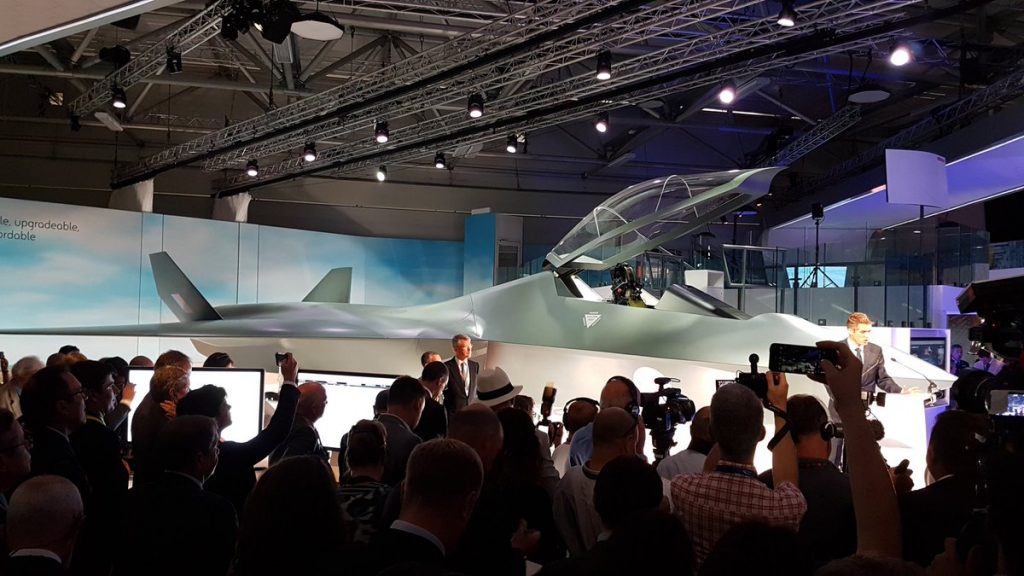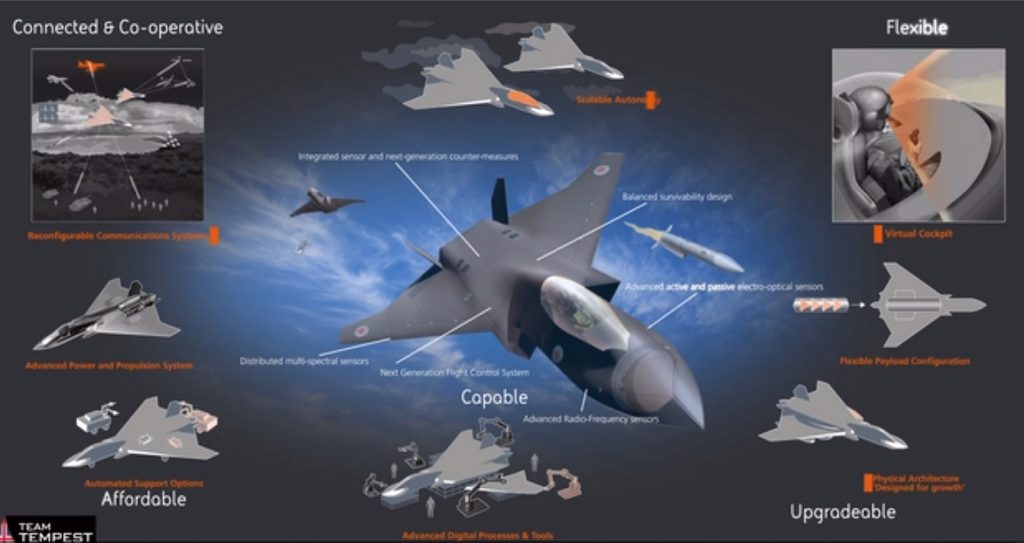UK unveils next-generation jet fighter during Farnborough Airshow
Posted on
On 16 July, during the Farnborough International Airshow 2018, for the first time was unveiled a concept of next-generation jet fighter developing as a part of Future Combat Air Concept programme.
The mock-up of newly fighter jet was unveiled at the Farnborough International Airshow 2018.
The new aircraft, nicknamed the Tempest, is a joint venture with British aerospace companies BAE Systems Plc, Rolls Royce Holdings Plc, MBDA UK Ltd and Anglo-Italian firm Leonardo SpA.
“We are entering a dangerous new era in warfare,” Williamson said, pulling a curtain off the silver and white fighter jet. The U.K. aims to “keep control of the air both at home and abroad.” He called for more details of the business case to be set out by the end of this year, with the ultimate goal for the aircraft to be operational in 2035.
The UK Secretary of State for Defence, Gavin Williamson also announced USD2.65 billion of government funding to oversee the design and build of the aircraft through 2025, when a final decision would be taken on the program’s future.
At the Farnborough International Air Show a next-generation fighter concept model was revealed showcasing key technologies that will be important in the future. The concept gives an indication of the types of technologies that we and our partners are developing and investing in so that we can deliver world leading capabilities for the future.

A future combat air system must be able to survive the most challenging combat environments meaning that payload-range, speed and manoeuvrability will be key. We expect that the system will be equipped with a range of sensors including radio frequency, active and passive electro-optical sensors and advanced electronic support measures to detect and intercept threats.
The system is likely to operate with kinetic and non-kinetic weapons. The integration of Laser Directed Energy Weapons for self-defence and use within visual range combat is also highly likely. The ability to deploy and manage air launched ‘swarming’ Unmanned Air Vehicles (UAV) through a flexible payload bay allows the system to address dangerous Anti-Access Area Denial environments.
Air forces of the future will require a fighter system that is highly flexible and can be applied to a wide variety of military operations. Operators will have the ability to rapidly adapt the system to perform new functions or to change its performance.
Depending on the mission, ‘role fit’ additions such as low observable conformal fuel tanks, weapons dispensers, air launched UAV dispensers, large modular sensors, long range oblique photography systems for reconnaissance and Laser Directed Energy Weapons could be available.
Adaptability will be built into the system design, with systems architectures which support a ‘plug and play’ approach, easily integrating new algorithms and hardware. The system will also support ‘scalable autonomy’ to provide a number of modes of unmanned operation and a range pilot decisions aids when manned flight is being conducted. These features are dynamically reconfigurable and serve to enhance survivability, availability, cyber resilience, and tactical options.

To deliver significant information advantage and mission effectiveness, the future combat air system will act as a ‘force multiplier’, interoperating with a wide range of other civil and military platforms and services across air, land, sea, space and cyber domains – as well as unmanned systems.
Command and control of other systems, such as UAVs, will be enabled from a fully customisable virtual cockpit, with advanced human machine interfaces including eye tracking and gesture based controls, offering intuitive and sophisticated mission management. Using a similar virtual approach, both mission planning on the ground, and the remote command of unmanned aircraft can be enhanced, ensuring a rapid and effective understanding of the battlespace.
The FCAS will be quickly and affordably upgradable, maintaining Operational Advantage and Freedom of Action in a rapidly evolving threat environment.
Physical interfaces must therefore be strong, lightweight, numerous, and affordably produced. This will be achieved through our expertise in additive layer manufacture, joining and fastener technology, ‘geometric locking’, and low observable materials. Robotic and cobotic assembly is likely to play a significant role.
The U.K.also is in discussions with other countries about partnering on the project that would also maintain some 18,000 jobs at home. Suggestions include a pact with Sweden, where Saab AB makes the Gripen fighter, or possibly Japan and elsewhere in Asia, where demand for warplanes is increasing as China and India flex their military muscle, the person said.
The fighter jet is under development by “Team Tempest,” a joint operation between the aerospace companies and the Royal Air Force’s Rapid Capability Office under the Future Combat Air Strategy Technology Initiative. It could end up competing with a model being developed by France and Germany, potentially ending decades of cross-channel cooperation on warplane production, according to a person familiar with the program.
Surely Tempest III after original Hawker Tempest, and Tempest II? #FIA18 #avgeek pic.twitter.com/U34N5nhWG8
— Tim Robinson (@RAeSTimR) 16 July 2018
Subscribe to our newsletter
Promotions, new products and sales. Directly to your inbox.
